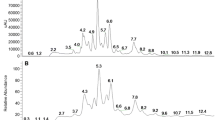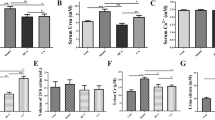Abstract
Quercetin and hyperoside (QH) are the two main constituents of the total flavone glycosides of Flos Abelmoschus manihot, which has been prescribed for treating chronic kidney disease for decades. This study aimed to investigate the effect of QH on calcium oxalate (CaOx) formation in ethylene glycol (EG)-fed rats. Rats were divided into three groups: an untreated stone-forming group, a QH-treated stone-forming group (20 mg/kg/day) and a potassium citrate-treated stone-forming group (potassium citrate was a worldwide-recognized calculi-prophylactic medicine). Ethylene glycol (0.5 %) was administered to the rats during the last week, and vitamin D3 was force-fed to induce hyperoxaluria and kidney calcium oxalate crystal deposition. 24 h urine samples were collected before and after inducing crystal deposits. Rats were killed and both kidneys were harvested after 3 weeks. Bisected kidneys were examined under a polarized light microscope for semi-quantification of the crystal-formation. The renal tissue superoxide dismutase and catalase levels were measured by Western blot. QH and potassium citrate have the ability to alkalinize urine. The number of crystal deposits decreased significantly in the QH-treated stone-forming group as compared to the other groups. Superoxide dismutase and catalase levels also increased significantly in the QH-treated stone-forming group, as compared with the untreated stone-forming group. QH administration has an inhibitory effect on the deposition of CaOx crystal in EG-fed rats and may be effective for preventing stone-forming disease.



Similar content being viewed by others
Abbreviations
- QH:
-
Quercetin and hyperoside
- CaOx:
-
Calcium oxalate
- EG:
-
Ethylene glycol
- KCit:
-
Potassium citrate
- SOD:
-
Superoxide dismutase
- NaCl:
-
Sodium chloride
- SDS:
-
Sodium dodecyl sulfate
- PAGE:
-
Polyacrylamide gel electrophoresis
- BSA:
-
Bovine serum albumin
References
Bansal AD, Hui J, Goldfarb DS (2009) Asymptomatic nephrolithiasis detected by ultrasound. CJASN 4:680–684
Zeng Q, He Y (2013) Age-specific prevalence of kidney stones in chinese urban inhabitants. Urol 41:91–93
Zhou L, An XF, Teng SC, Liu JS, Shang WB, Zhang AH, Yuan YG, Yu JY (2012) Pretreatment with the total flavone glycosides of flos abelmoschus manihot and hyperoside prevents glomerular podocyte apoptosis in streptozotocin-induced diabetic nephropathy. J Med Food 15:461–468
Dong YS, Wang JL, Feng DY, Qin HZ, Wen H, Yin ZM, Gao GD, Li C (2014) Protective effect of quercetin against oxidative stress and brain edema in an experimental rat model of subarachnoid hemorrhage. Int J Med Sci 11:282–290
Rahman MM, Habib MR, Hasan MA, Al Amin M, Saha A, Mannan A (2014) Comparative assessment on in vitro antioxidant activities of ethanol extracts of averrhoa bilimbi, gymnema sylvestre and capsicum frutescens. Pharmacogn Res 6:36–41
Al-Rasheed NM, Faddah LM, Mohamed AM (2013) Abdel Baky NA, Al-Rasheed NM, Mohammad RA Potential impact of quercetin and idebenone against immuno- inflammatory and oxidative renal damage induced in rats by titanium dioxide nanoparticles toxicity. J Oleo Sci 62:961–971
Park HK, Jeong BC, Sung MK, Park MY, Choi EY, Kim BS, Kim HH, Kim JI (2008) Reduction of oxidative stress in cultured renal tubular cells and preventive effects on renal stone formation by the bioflavonoid quercetin. J Urol 179:1620–1626
Li W, Liu M, Xu YF, Feng Y, Che JP, Wang GC, Zheng JH (2014) Combination of quercetin and hyperoside has anticancer effects on renal cancer cells through inhibition of oncogenic microRNA-27a. Oncol Rep 31:117–124
Premgamone A, Sriboonlue P, Disatapornjaroen W, Maskasem S, Sinsupan N, Apinives C (2001) A long-term study on the efficacy of a herbal plant Orthosiphon grandiflorus, and sodium potassium citrate in renal calculi treatment. The Southeast Asian J Trop Med Public Health 32:654–660
Fishman AI, Green D, Lynch A, Choudhury M, Eshghi M, Konno S (2013) Preventive effect of specific antioxidant on oxidative renal cell injury associated with renal crystal formation. Urol 82(489):e481–e487
Fink HA, Wilt TJ, Eidman KE, Garimella PS, MacDonald R, Rutks IR, Brasure M, Kane RL, Ouellette J, Monga M (2013) Medical management to prevent recurrent nephrolithiasis in adults: a systematic review for an american college of physicians clinical guideline. Ann Intern Med 158:535–543
Atmani F, Khan SR (2000) Effects of an extract from herniaria hirsuta on calcium oxalate crystallization in vitro. BJU Int 85:621–625
Freitas AM, Schor N, Boim MA (2002) The effect of Phyllanthus niruri on urinary inhibitors of calcium oxalate crystallization and other factors associated with renal stone formation. BJU Int 89:829–834
Bouanani S, Henchiri C, Migianu-Griffoni E, Aouf N, Lecouvey M (2010) Pharmacological and toxicological effects of Paronychia argentea in experimental calcium oxalate nephrolithiasis in rats. J Ethnopharmacol 129:38–45
Duan CY, Xia ZY, Zhang GN, Gui BS, Xue JF, Ouyang JM (2013) Changes in urinary nanocrystallites in calcium oxalate stone formers before and after potassium citrate intake. Int J Nanomed 8:909–918
Aslani A, Fattahi F (2013) Formulation, characterization and physicochemical evaluation of potassium citrate effervescent tablets. Adv Pharm Bull 3:217–225
Pinheiro VB, Baxmann AC, Tiselius HG, Heilberg IP (2013) The effect of sodium bicarbonate upon urinary citrate excretion in calcium stone formers. Urol 82:33–37
Khaskhali MH, Byer KJ, Khan SR (2009) The effect of calcium on calcium oxalate monohydrate crystal-induced renal epithelial injury. Urol Res 37:1–6
Lee HJ, Jeong SJ, Lee HJ, Lee EO, Bae H, Lieske JC, Kim SH (2011) 1,2,3,4,6-Penta-O-galloyl-beta-d-glucose reduces renal crystallization and oxidative stress in a hyperoxaluric rat model. Kidney Int 79:538–545
Pareta SK, Patra KC, Mazumder PM, Sasmal D (2011) Aqueous extract of Boerhaavia diffusa root ameliorates ethylene glycol-induced hyperoxaluric oxidative stress and renal injury in rat kidney. Pharm Biol 49:1224–1233
Khan SR (2011) Crystal/cell interaction and nephrolithiasis. Archivio italiano di urologia, andrologia: organo ufficiale [di] Societa italiana di ecografia urologica e nefrologica/Associazione ricerche in urologia 83:1–5
Hirose Y, Yasui T, Taguchi K, Fujii Y, Niimi K, Hamamoto S, Okada A, Kubota Y, Kawai N, Itoh Y, Tozawa K, Sasaki S, Kohri K (2013) Oxygen nano-bubble water reduces calcium oxalate deposits and tubular cell injury in ethylene glycol-treated rat kidney. Urol 41:279–294
Akanae W, Tsujihata M, Yoshioka I, Nonomura N, Okuyama A (2010) Orthosiphon grandiflorum has a protective effect in a calcium oxalate stone forming rat model. Urol Res 38:89–96
Yang Y, Yuan F, Wei L, Jian-ping C, Guang-chun W, Min L and Jun-hua Z (2014) Protective effects of quercetin and hyperoside on renal fibrosis in rats with unilateral ureteral obstruction. Exp Ther Med 8:727–730
Miyaoka R, Monga M (2009) Use of traditional chinese medicine in the management of urinary stone disease. Int Braz J Urol 35:396–405
Zhai W, Zheng J, Yao X, Peng B, Liu M, Huang J, Wang G, Xu Y (2013) Catechin prevents the calcium oxalate monohydrate induced renal calcium crystallization in NRK-52E cells and the ethylene glycol induced renal stone formation in rat. BMC Complement Altern Med 13:228
Mahmoud MF, Hassan NA, El Bassossy HM, Fahmy A (2013) Quercetin protects against diabetes-induced exaggerated vasoconstriction in rats: effect on low grade inflammation. PloS One 8:e63784
Hsieh CL, Peng CC, Chen KC, Peng RY (2013) Rutin (quercetin rutinoside) induced protein-energy malnutrition in chronic kidney disease, but quercetin acted beneficially. J Agric Food Chem 61(30):7258–7267
Acknowledgments
This work was partially supported by grants from the National Natural Science Foundation of China (No. 81000311 and No. 81270831).
Conflict of interest
The authors declared no potential conflicts of interests with respect to the authorship and/or publication of this article.
Author information
Authors and Affiliations
Corresponding authors
Additional information
W. Zhu, Y. Xu and Y. Feng are equal first contributors for this work.
Rights and permissions
About this article
Cite this article
Zhu, W., Xu, Yf., Feng, Y. et al. Prophylactic effects of quercetin and hyperoside in a calcium oxalate stone forming rat model. Urolithiasis 42, 519–526 (2014). https://doi.org/10.1007/s00240-014-0695-7
Received:
Accepted:
Published:
Issue Date:
DOI: https://doi.org/10.1007/s00240-014-0695-7




